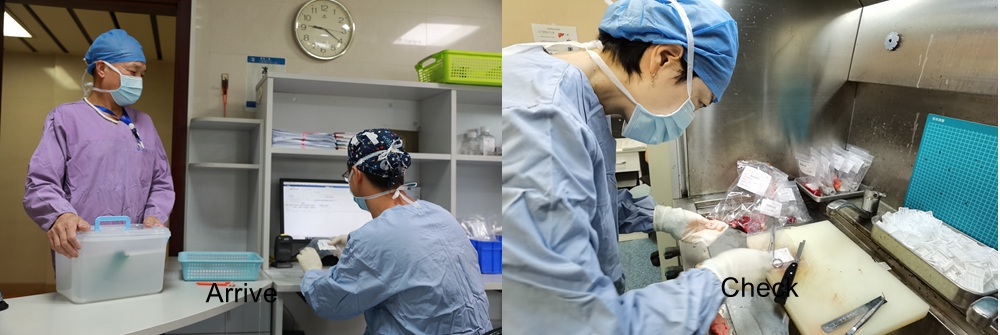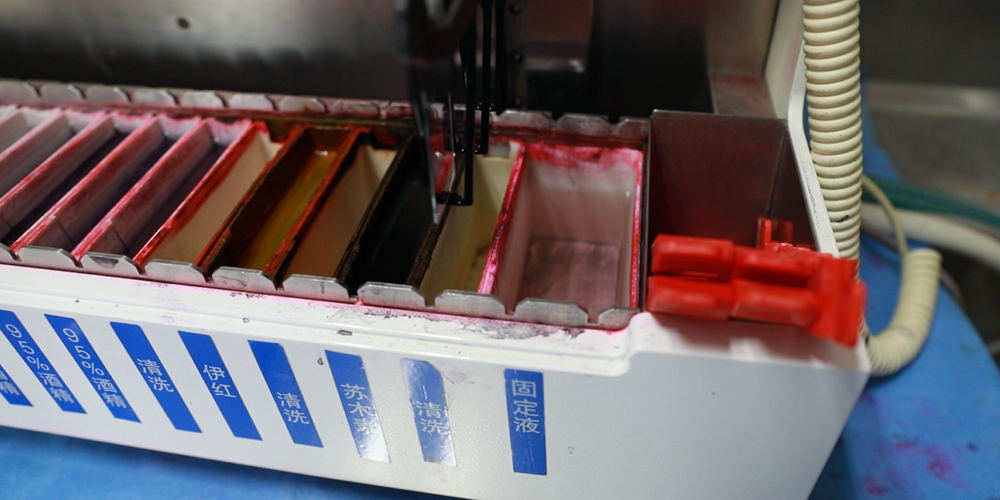
Pathologists in the Intraoperative Frozen Section Pathology Lab
They are the ultimate judge in an operating room
What they carry is the weight of life
Every second, every minute
Never let off, never miss out, never make wrong judgement
This is who they are
This is the professionalism of all pathologists
This is their highest respect for life and career choice
During a tumor resection surgery, a small piece of tissue is removed and sent to the Intraoperative Frozen Section Pathology Lab for rapid analysis, leaving the entire OR to wait for the final "judgement call". Whether to remove the nodule only or to perform a total resection. Surgeons urgently need the pathological diagnosis to determine the next step.
At SAHZU, Intraoperative Frozen Section Pathology Lab is part of the Department of Pathology and is responsible for a rapid analysis of pathological samples for all the operations during the day. Currently, this lab has been founded in all the three campuses of SAHZU, including Jiefang, Binjiang and Chengdong.
From the moment that the tissue sample arrives, a process which includes identification, sampling, freezing, slicing, staining, diagnosis and reporting needs to be finished within 30 minutes in this lab.
- Once the tissue sample arrives, identification is the beginning step. A precise sampling is the primary premise to an accurate pathological diagnosis. To become a qualified pathologist, 7-8 years’ experience and practice in sampling collection is necessary so that one could see sharply and feel accurately.

- Knifes, scissors, tweezer, ruler and "freezing head" (a tool with a shape like small candlestick) are used successively to carry out a quick freezing. Once the tissue is frozen, a slice will be extracted from it gently, spread over, pressed and fixed on a glass slide firmly.

- The next step is to stain it. Eosin, hematoxylin, gradient alcohol, these are the dye components often used in H&E staining method. The slide is rinsed in different solutions automatically to complete the fixation and staining process, which enables pathologists to achieve better visualization and discernment of the sample’s microscopic details. SAHZU pathologists like to refer to this step as "makeup setting". After staining, the coverslips are placed and the sample is ready for review.

Once the sample is prepared and placed under the microscope, doctors start to observe and diagnose. The diagnosis however can be the hardest step since based merely on some cells, the pathologists have to tell whether the tumor is benign or not.
Through microscope, a microscopic world that we hardly see is presented. Perhaps you have seen very beautiful samples as followings:

But in fact, what the pathologists looking at in the Lab are like these:

That is to say that the image of an intraoperative frozen section is not as distinct as that of conventional samples, but pathologists still need to observe carefully and make an accurate diagnosis.
Pathologists start their career as residents. They have to spend at least 7 or 8 years first on sharpening their sampling skills before taking on tasks of pathological diagnosis on regular samples. Only with a certain level of competence and experience will they be assigned to the intraoperative frozen section pathology lab.
Time-sensitive, heavy work load and stressful can be used to describe the daily work of a pathologist.
Now in the Department of Pathology at SAHZU, there are 17 pathologists working in the Intraoperative Frozen Section Pathology Lab all year round. Together with pathology technicians, they provide reports with crucial results for surgeons to make quick and accurate decisions.
A pathology report is a paper that makes a difference to the life of a patient since benign or malignant tumor can mean highly different surgical approaches. If it is benign, then removing the tumor will be enough, but if it is malignant, or somewhere in between, then a surgery with greater resection will be needed.
For pathologists, on the one hand they are glad to “capture” a malignant tumor, but on the other hand they surely feel sad for the patient. Nevertheless, no matter a tumor is diagnosed as benign or not, it is a professional judgment given by pathologists who have been perfecting their skills through decades of hard work.
Professionalism and humanity are thus intertwined in the role of pathologists, becoming the origin of warmness and trust that we can find in them.
Author:CHEN LU, LI JING | Reviewer: LI JING | Editor: LI JING | Source: SAHZU OFFICIAL WECHAT | Date:2021-10-12 | Views:![]()
![]()